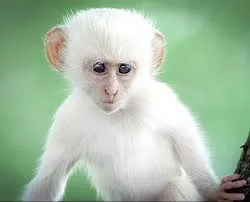Monkeys are fascinating creatures with a wide range of colors, behaviors, and adaptations that make them unique in the animal kingdom. One of the rarest and most visually striking types of monkeys is the albino monkey. The condition of albinism causes these monkeys to have a lack of pigmentation, giving them a distinct white or pale appearance, often with light pink or red eyes. These rare creatures have sparked the curiosity of animal lovers and scientists alike.
In this article, we’ll present albino monkey facts, including what albinism is, how it affects these primates, where they are found, and why they are so rare. We’ll also dive into the challenges albino monkeys face in the wild and the myths surrounding them.
What is an Albino Monkey?
An albino monkey is a monkey born with a genetic mutation that prevents it from producing pigment (melanin) in its fur, skin, and eyes. Albinism occurs when both parents carry the recessive gene for the condition, and it’s passed on to their offspring. As a result, albino monkeys appear with white or pale fur, pink or red eyes, and light skin.
This genetic anomaly can happen in many species of primates, although it is rare due to the recessive nature of the gene. The lack of melanin makes albino monkeys highly noticeable, which can be both an advantage and a disadvantage in the wild.
How Rare Are Albino Monkeys?

Albino monkeys are extremely rare, with only a small percentage of monkey populations being born with this condition. Albinism occurs in about 1 in 10,000 to 1 in 100,000 animals in general, depending on the species. For monkeys, the occurrence of albinism is even less common, making the birth of an albino monkey an extraordinary event.
In some cases, albino monkeys have been spotted in the wild, but these animals are often captured and brought to zoos for protection. The rarity of albino monkeys is compounded by the challenges they face in the wild, where their appearance can make them more vulnerable to predators.
Albino Monkey Species
While albino monkeys can technically be born in almost any monkey species, there are a few species in which they are more likely to be spotted. These include:
1. Macaca Fascicularis (Long-tailed macaque)
The long-tailed macaque, found in Southeast Asia, is one of the species where albino individuals have been occasionally spotted. These monkeys are known for their adaptability and social structures, which might help them cope with the challenges of albinism.
2. Cercopithecus (African monkeys)
Albino monkeys have been observed in several species of African monkeys, particularly the Cercopithecus genus, which includes monkeys such as the red-tailed monkey and grivet monkey. Albino individuals are rare, but they still represent a fascinating example of genetic variation.
3. Capuchin Monkeys
The capuchin monkey, famous for its intelligence and often featured in movies and TV shows, has been the subject of reports about rare albino births in captivity.
4. Marmosets and Tamarins
In smaller primates like marmosets and tamarins, the occurrence of albinism is particularly striking due to their small size and complex social structures. These monkeys are found primarily in South America, where albino individuals have occasionally been reported.
Albino Monkey Behavior and Challenges
Although albino monkeys may have similar behaviors to their non-albino relatives, they face specific challenges that make their survival in the wild more difficult:
1. Vulnerability to Predators
Albino monkeys are highly visible due to their pale fur and pink or red eyes, which makes them easier for predators to spot. In the wild, where camouflage is key to survival, this lack of pigmentation can make albino monkeys more vulnerable to hunting and attacks.
2. Social Isolation
Monkeys are social animals, and in the wild, appearance can be important for group identification and bonding. Albino monkeys may experience social isolation because their appearance differs significantly from that of other monkeys in their group. This could lead to them being excluded or ostracized, especially if they are unable to blend in with the rest of the group.
3. Health Problems
Albino animals, including monkeys, often face health issues related to the lack of melanin. Albino monkeys are more likely to suffer from vision problems (such as photophobia or sensitivity to light), skin damage from exposure to the sun, and weakened immune systems. These issues can make them more vulnerable to disease and injury.
4. Lack of Camouflage
Primates, including monkeys, use their fur as camouflage in their natural environment. Albino monkeys, with their light-colored fur, are more noticeable to predators and prey, making it harder for them to blend into the environment.
Interesting Facts About Albino Monkeys
- Albino monkeys are not albino because of a lack of hair. Albinism in monkeys affects their pigmentation, not just the color of their fur. The lack of melanin also affects their skin and eyes.
- Albino monkeys are more susceptible to vision problems, such as being overly sensitive to bright light, because they lack the natural pigmentation that protects the eyes from sunlight.
- In some cultures, albino monkeys are considered mystical or sacred. In certain regions, albino animals are seen as symbols of good luck or spiritual significance.
- Albino monkeys in captivity often receive special care. In zoos and animal sanctuaries, albino monkeys are given extra protection from the sun, and their health is closely monitored to ensure they don’t suffer from common health problems associated with albinism.
- Albinism can occur in both male and female monkeys, though it’s difficult to track exact gender-related patterns due to the rarity of the condition.
Albino Monkeys in Pop Culture
Albino monkeys have captured the imagination of many people worldwide, often appearing in pop culture and stories. From documentaries to movies, albino monkeys represent the unusual and rare side of the animal kingdom.
While these monkeys are not commonly featured in movies, their striking appearance and rarity often make them memorable characters when they do appear. Some popular media outlets have showcased albino monkeys as symbols of rarity or to highlight environmental issues related to wildlife.
Conclusion: The Wonder of Albino Monkeys
Albino monkeys are rare and captivating creatures, with their unique appearance and the challenges they face in the wild. From their vulnerability to predators to their possible social isolation, albino monkeys represent a fascinating combination of nature’s wonders and its vulnerabilities. While they are a rarity in the primate world, their presence is a reminder of the diversity and complexity of life on Earth.
As we continue to learn more about these rare creatures, it is important to recognize the need for their protection in the wild, especially as habitat loss and climate change continue to threaten the survival of many species of primates.
FAQ – Albino Monkey Facts
1. What is an albino monkey?
An albino monkey is a monkey born with albinism, a genetic condition that causes a lack of pigmentation in their fur, skin, and eyes. This results in a pale or white appearance, with pink or red eyes.
2. How rare are albino monkeys?
Albino monkeys are extremely rare. Albinism occurs in about 1 in 10,000 to 1 in 100,000 animals in general, and it’s even less common in monkeys. The birth of an albino monkey is considered an extraordinary event.
3. What species of monkeys can be albino?
Albino monkeys have been reported in several species, including long-tailed macaques, capuchin monkeys, marmosets, tamarins, and various African primates like the Cercopithecus genus. However, their occurrence is rare across all species.
4. What challenges do albino monkeys face in the wild?
Albino monkeys face several challenges, including vulnerability to predators due to their lack of camouflage, social isolation because of their unusual appearance, and potential health issues such as poor vision and skin sensitivity to sunlight.
5. Do albino monkeys have health problems?
Yes, albino monkeys are more prone to vision problems (such as sensitivity to bright light), skin damage from UV exposure, and may have a weakened immune system due to their lack of pigmentation. These health challenges can make it harder for them to survive in the wild.
6. Are albino monkeys considered special in any cultures?
In some cultures, albino monkeys are seen as mystical or sacred animals. Their rarity and unique appearance often lead to them being considered symbols of good fortune or spiritual significance in certain regions.
7. Can albino monkeys live in zoos or sanctuaries?
Yes, albino monkeys are often taken into zoos or sanctuaries, where they receive special care to protect them from the sun and ensure their health is monitored. These facilities provide an environment where they can be safe from predators and receive the care they need.
